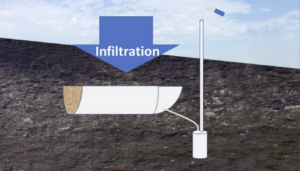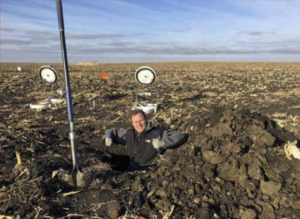Getting into Soil and Water 2020

Nitrogen is an essential nutrient for all life. Iowa farmers help ensure their crops have enough nitrogen by growing nitrogen-fixing plants, like soybeans, or by applying fertilizer and manure. Ideally, nitrogen is taken up by the crops and removed with harvest. Unfortunately, nitrogen is also lost to the environment, primarily to the air and water (Libra, Wolter, & Langel, 2004). When water moves through the soil it can take nitrogen with it, particularly in the form of nitrate (Jones, Nielsen, Schilling, & Weber, 2018). This process is called leaching, and it carries nitrate from soils to surface and ground waters. Excess nitrate in drinking water is unsafe for human consumption. In lakes, streams, and the Gulf of Mexico, too much nitrate contributes to algal blooms, which can suffocate fish and other animals when the algae decays. Nitrogen is also lost to the air through denitrification, where microbes respire nitrate instead of oxygen when oxygen is unavailable, such as periods when soils are saturated with water. Denitrification converts nitrate to three gases: nitric oxide, nitrous oxide, and dinitrogen gas. Iowa soils have been shown to produce little nitric oxide, so we will focus on nitrous oxide and dinitrogen gas (Hall, Reyes, Huang, & Homyak, 2018). Dinitrogen gas is harmless and makes up approximately 80% of the atmosphere. Nitrous oxide, on the other hand, is a powerful greenhouse gas that contributes to global warming and the destruction of the ozone layer. Regardless of the gas produced, denitrification in soils removes nitrogen that could have been utilized by crops.
At Iowa State University, our lab researches how to reduce nitrate leaching and denitrification to nitrous oxide gas. We are particularly interested in how topography plays a role in both processes. In north-central Iowa, the topography
of the Des Moines Lobe is dominated by former depressional wetlands, commonly referred to as potholes. Despite extensive attempts to drain potholes to prevent their flooding and allow crops to be cultivated, the potholes still flood in wet years and generally have higher soil moisture than the surrounding uplands (Logsdon, 2015). As water is required for leaching and is expected to promote denitrification by limiting oxygen availability, we wanted to investigate if potholes had higher rates of both.
To answer these questions, we installed lysimeters in a line from the center of
a pothole to the surrounding uplands (Figure 2). Each lysimeter diverted soil water as it flowed through the soil to a collection container (Figure 1). After each precipitation event, we measured the volume of water and the concentration of nitrate and other forms of nitrogen in the diverted water to quantify how much nitrogen was leached. Our results suggest higher rates of leaching in potholes than in the surrounding uplands (N. Lawrence, unpublished). Thanks to a grant from the Iowa Water Center, we were also able to quantify total denitrification across the pothole through a cutting-edge isotopic technique. Our results indicate that the potholes support only slightly higher rates of denitrification than the surrounding uplands. Collectively, these results suggest that potholes are a source of nitrate leaching to downstream ecosystems and are poorly effective at removing nitrogen through denitrification.

Future research will focus on strategies to reduce leaching and denitrification to nitrous oxide. Potholes could be targeted for alternative management to help achieve these goals. Perennial plants such as bioenergy crops may be able to reduce leaching by more effectively taking up nitrogen and water (McIsaac, David, & Mitchell, 2010). These crops could also reduce denitrification to nitrous oxide by similarly reducing the nitrate required for denitrification. We are currently investigating whether planting a perennial bioenergy crop will reduce leaching and denitrification to nitrous oxide.
Nate Lawrence
PhD Candidate Department of Ecology, Evolution and Organismal Biology, Iowa State University
References:
Hall, S. J., Reyes, L., Huang, W., & Homyak, P. M. (2018). Wet Spots as Hotspots: Moisture Responses of Nitric and Nitrous Oxide Emissions from Poorly Drained Agricultural Soils. Journal of Geophysical Research: Biogeosciences, 123(12), 3589–3602.
Jones, C. S., Nielsen, J. K., Schilling, K. E., & Weber, L. J. (2018). Iowa stream nitrate and the Gulf of Mexico. PLOS ONE, 13(4), e0195930.
Libra, R., Wolter, C., & Langel, R. (2004). Nitrogen and phosphorus budgets for Iowa and Iowa watersheds. Technical Information Series.
Logsdon, S. D. (2015). Event- and Site-Specific Soil Wetting and Seasonal Change in Amount of Soil Water. Soil Science Society of America Journal, 79(3), 730–741.
McIsaac, G. F., David, M. B., & Mitchell, C. A. (2010).
Miscanthus and Switchgrass Production in Central Illinois: Impacts on Hydrology and Inorganic Nitrogen Leaching. Journal of Environmental Quality, 39(5), 1790–1799.